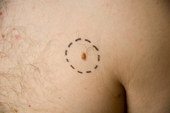Types and Stages of Melanoma
Melanoma is the most serious and deadly form of skin cancer, but it is not as common as other types. However, the incidence of melanoma continues to rise in the United States population. The risks for melanoma increase as we age, but it is often seen in younger people. There are four main kinds of melanoma as well as several rare types of this condition.
Main Types of Melanoma
Superficial Spreading Melanoma
This is by far the most prevalent kind of melanoma, making up 70% of diagnosed cases. Superficial spreading melanoma is the number one cancer killer among young people. Generally, it is irregular in shape, appears flat, and has differing shades of brown and black. Superficial spreading melanoma is most common in the Caucasian population of the United States.
Nodular Melanoma
This type of skin cancer normally begins as an elevated skin area that is dark bluish-red or blackish-blue in color. At times, nodular melanoma has no color. While it only accounts for 15% of melanomas, this is the most aggressive kind. Nodular melanoma spreads to the internal organs quickly and leads to death if not treated early.
Lentigo Maligna Melanoma
Commonly occurring in the elderly, lentigo maligna melanoma develops on the sun damaged skin of the face, arms and/or neck. Making up 10% of melanomas, it can be misdiagnosed as common sun spots. Atypical areas of lentigo maligna melanoma are generally large and flat. The coloration of this form of melanoma is tan with brown sections.
Acral Lentiginous Melanoma
Acral lentiginous melanoma occurs most often on the palms of the hands, the soles of the feet and/or under the nail beds. While it is the least prevalent type of melanoma (5%), acral lentiginous tends to be quite common in African American and Asian individuals, making up 50% of diagnosed melanomas in these two groups of the U.S. population.
Rare Forms of Melanoma
On rare occasions, melanoma develops within the iris or retina of the eyes and also in the mouth. Eye doctors and dentists may discover these melanoma tumors during routine examinations. Melanomas can also occur in the esophagus, vagina, anus, urinary tract and the small intestines. However, those of the urinary and gastrointestinal tracts are very rare.
Stages of Malignant Melanoma
A melanoma tumor is always classified according to its stage. The specific stage depends on the tumor size, location and the extent of metastasis (spreading). Staging helps healthcare professionals make decisions on appropriate treatment plans. The following chart summarizes the stages of melanoma tumors.
| Tumor Stage | Description: |
| IA | -one millimeter in diameter with no accompanying ulceration-no involvement of the surrounding lymph nodes and no distant metastases |
| IB | -less than or equal to one millimeter in diameter with accompanying ulceration-tumor with a diameter of one to two millimeters with no ulceration and no lymph node involvement or any distant metastases |
| IIA | -tumor greater than one millimeter to two millimeter accompanied by ulceration-tumor greater than two and up to four millimeters without any ulceration and no involvement of surrounding lymph node and no spreading |
| IIB | -tumor between two and four millimeters with some degree of ulceration |
| IIB | -tumor greater than four millimetres without any ulceration or lymph node involvement and without any metastases |
| IIC | -tumor larger than four millimetres with ulceration and no node involvement or metastases |
| IIIA | -tumor with no accompanying ulceration but involving one lymph node |
| IIIB | -any degree of thickness, no ulceration of the tumor-two to three lymph nodes positive for melanoma |
| IIIC | -tumors of any thickness and 4 or more involved lymph nodes or clumped nodes-in transit and/or satellite metastases with no metastatic lymph nodes or metastatic lymph node(s) and ulcerated melanoma |
| IV | -tumor of any thickness with no specific number of involved nodes and with any distant metastases to other distant areas of the skin or to the lungs, brain or liver |
Prevention of Melanoma
If melanoma skin lesions are discovered early and treated promptly, the disease has a 98% to 100% cure rate. There are some things you can do either prevent melanoma or increase your chances of getting early detection and treatment. These include:
- Give yourself a skin screen – The American Academy of Dermatology strongly recommends examining the entire body on a regular basis for any changes in the skin’s overall appearance.
- Consult your doctor –See a dermatologist immediately if an unusual skin lesion seems to be growing in size, bleeding, or does not look like the same as other moles.
- Get a free skin cancer screening done – The American Academy of Dermatology sponsors free skin screenings at various locations throughout the country.
- Avoid harmful rays – Stop the dangerous practices of excessive sun exposure or using a commercial tanning bed.
- Wear sunscreen and cover up – Use at least an SPF 30 UVA/UVB sunscreen, wear a hat, sunglasses and long, and choose loose fitting clothing when going outside to enjoy the sunshine.
- Avoid peak sun times –The rays are the most harmful between 10AM and 2PM. Dermatologists advise you to stay in during these times, as this is when ultraviolet rays are the most intense.

